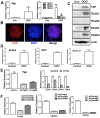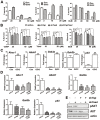YAP/TEAD co-activator regulated pluripotency and chemoresistance in ovarian cancer initiated cells
- PMID: 25369529
- PMCID: PMC4219672
- DOI: 10.1371/journal.pone.0109575
YAP/TEAD co-activator regulated pluripotency and chemoresistance in ovarian cancer initiated cells
Abstract
Recent evidence suggests that some solid tumors, including ovarian cancer, contain distinct populations of stem cells that are responsible for tumor initiation, growth, chemo-resistance, and recurrence. The Hippo pathway has attracted considerable attention and some investigators have focused on YAP functions for maintaining stemness and cell differentiation. In this study, we successfully isolated the ovarian cancer initiating cells (OCICs) and demonstrated YAP promoted self-renewal of ovarian cancer initiated cell (OCIC) through its downstream co-activator TEAD. YAP and TEAD families were required for maintaining the expression of specific genes that may be involved in OCICs' stemness and chemoresistance. Taken together, our data first indicate that YAP/TEAD co-activator regulated ovarian cancer initiated cell pluripotency and chemo-resistance. It proposed a new mechanism on the drug resistance in cancer stem cell that Hippo-YAP signal pathway might serve as therapeutic targets for ovarian cancer treatment in clinical.
Conflict of interest statement
Figures






Similar articles
-
Statin suppresses Hippo pathway-inactivated malignant mesothelioma cells and blocks the YAP/CD44 growth stimulatory axis.Cancer Lett. 2017 Jan 28;385:215-224. doi: 10.1016/j.canlet.2016.10.020. Epub 2016 Oct 20. Cancer Lett. 2017. PMID: 27773750
-
Targeting YAP/TAZ-TEAD signaling as a therapeutic approach in head and neck squamous cell carcinoma.Cancer Lett. 2025 Mar 1;612:217467. doi: 10.1016/j.canlet.2025.217467. Epub 2025 Jan 16. Cancer Lett. 2025. PMID: 39826667
-
Hippo effector YAP directly regulates the expression of PD-L1 transcripts in EGFR-TKI-resistant lung adenocarcinoma.Biochem Biophys Res Commun. 2017 Sep 16;491(2):493-499. doi: 10.1016/j.bbrc.2017.07.007. Epub 2017 Jul 3. Biochem Biophys Res Commun. 2017. PMID: 28684311
-
The TEAD Family and Its Oncogenic Role in Promoting Tumorigenesis.Int J Mol Sci. 2016 Jan 21;17(1):138. doi: 10.3390/ijms17010138. Int J Mol Sci. 2016. PMID: 26805820 Free PMC article. Review.
-
A combat with the YAP/TAZ-TEAD oncoproteins for cancer therapy.Theranostics. 2020 Feb 18;10(8):3622-3635. doi: 10.7150/thno.40889. eCollection 2020. Theranostics. 2020. PMID: 32206112 Free PMC article. Review.
Cited by
-
Small-sized colorectal cancer cells harbor metastatic tumor-initiating cells.Oncotarget. 2017 Nov 11;8(64):107907-107919. doi: 10.18632/oncotarget.22392. eCollection 2017 Dec 8. Oncotarget. 2017. PMID: 29296212 Free PMC article.
-
Role of the YAP Oncoprotein in Priming Ras-Driven Rhabdomyosarcoma.PLoS One. 2015 Oct 23;10(10):e0140781. doi: 10.1371/journal.pone.0140781. eCollection 2015. PLoS One. 2015. PMID: 26496700 Free PMC article.
-
Role of YAP in lung cancer resistance to cisplatin.Oncol Lett. 2018 Sep;16(3):3949-3954. doi: 10.3892/ol.2018.9141. Epub 2018 Jul 12. Oncol Lett. 2018. PMID: 30128013 Free PMC article.
-
Targeting ovarian cancer stem cells: a new way out.Stem Cell Res Ther. 2023 Feb 14;14(1):28. doi: 10.1186/s13287-023-03244-4. Stem Cell Res Ther. 2023. PMID: 36788591 Free PMC article. Review.
-
Targeting Cancer Stem Cells: A Strategy for Effective Eradication of Cancer.Cancers (Basel). 2019 May 27;11(5):732. doi: 10.3390/cancers11050732. Cancers (Basel). 2019. PMID: 31137841 Free PMC article. Review.
References
-
- Jemal A, Siegel R, Ward E, Hao Y, Xu J, et al. (2008) Cancer statistics, 2008. CA Cancer J Clin 58: 71–96. - PubMed
-
- Auersperg N, Wong AS, Choi KC, Kang SK, Leung PC (2001) Ovarian surface epithelium: biology, endocrinology, and pathology. Endocr Rev 22: 255–288. - PubMed
-
- Kulkarni-Datar K, Orsulic S, Foster R, Rueda BR (2013) Ovarian tumor initiating cell populations persist following paclitaxel and carboplatin chemotherapy treatment in vivo. Cancer Lett 339: 237–246. - PubMed
-
- Wang L, Mezencev R, Bowen NJ, Matyunina LV, McDonald JF (2012) Isolation and characterization of stem-like cells from a human ovarian cancer cell line. Mol Cell Biochem 363: 257–268. - PubMed
Publication types
MeSH terms
Substances
LinkOut - more resources
Full Text Sources
Other Literature Sources

